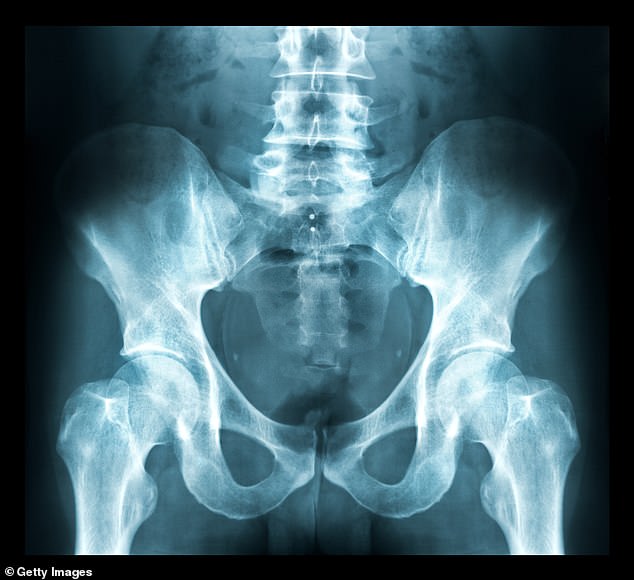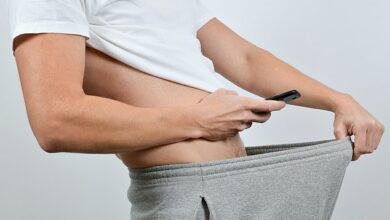Simple exercises that can help relieve the embarrassing pain that affects almost one in 10 men – who are often told nothing is wrong




Thousands of men are left with an embarrassing and debilitating condition, even though treatment can be as simple as a few minutes of daily exercise. Nearly one in 10 men will suffer from chronic testicular and penile pain at some point in their lives, which can make dressing uncomfortable and moving a pain in the ass.
According to experts, the condition is often mistaken for a sexually transmitted disease or dismissed as a symptom of depression or anxiety.
Mounting research suggests that these men can be effectively cured with a regimen of pelvic floor exercises, similar to those recommended for women to combat urinary incontinence after childbirth.
However, specialists have told The Mail on Sunday that the NHS has a ‘blind spot’ when it comes to this area of men’s health, meaning the condition, known as chronic pelvic pain syndrome (CPPS), often goes undiagnosed and untreated.

Jose Gonzalez Martinez began experiencing severe pain after recovering from a prostate infection. Doctors and scans found little to clarify until he was referred to Dr. Boylan
Patients sometimes have to pay for private treatment because some NHS physiotherapists will not treat men with pelvic floor problems.
According to experts, it is actually seen as a ‘women’s problem’.
‘Thousands of men suffer from these painful spasms in their pelvic area but are repeatedly told that there is nothing wrong,’ says Dr Johnny Boylan, a genitourinary specialist who runs the CPPS clinic at Liverpool University Hospitals NHS Foundation Trust. ‘Or they are given antibiotics for a possible infection, or painkillers.
‘But pain relief doesn’t solve the problem unless you address the underlying problem, and we know that rarely happens.
‘Physiotherapy or simple daily exercises that they can learn themselves could transform the lives of many of these men, but too often they don’t get this through the NHS. That needs to change.’
It is unclear how many men suffer from CPPS, but research published this year in the British Medical Journal suggests as many as one in 12 men have experienced it at some point.
The long-term pain often occurs in the testicles, the perineum (the area between the testicles and the anus), and the tip of the penis.
The sensation is often compared to a burning sensation or electric shocks passing through the affected area.
Patients report that the sensation can be so unpleasant that putting on long pants or trousers becomes unbearable, as the pressure causes flare-ups.
Pain in the genitals can also be a symptom of serious conditions, such as sexually transmitted diseases, kidney stones, and even cancer.
That’s why experts say it’s important for patients who experience these symptoms to always see their GP.
However, many GPs are not aware of the symptoms of CPPS and are often unable to help men who suffer from it.
Research shows that in some men the condition may be caused by an infection.

The pelvic floor is a group of muscles that support the spine, bladder and intestines
Other patients believe their CPPS is the result of stress.
Doctors often don’t know what causes the condition, or why it affects certain parts of the genitals and not others.
However, experts say it is becoming increasingly clear that CPPS is caused by a spasm of the pelvic floor muscles. The pelvic floor is a group of muscles that support the spine, bladder and bowels and is stretched like a hammock from the pubic bone in front to the tailbone in back.
It also ensures that we have control over our urine and bowel movements.
In women, it can be weakened by childbirth, leading to stress incontinence – involuntary urination or defecation during laughing, sneezing, or exercise.
According to the NHS, one in three women experience urinary incontinence in the first year after giving birth – and many continue to suffer for years. Women are advised to strengthen their pelvic floor by doing Kegel exercises – named after 20th century American gynaecologist Dr Arnold Kegel – which involve tensing the pelvic floor muscles for three to five seconds, then relaxing them for three to five seconds and repeating.
In June 2021, NHS England announced it would set up specialist pelvic clinics, staffed by physiotherapists, to treat tens of thousands of pregnant women and new mothers with pelvic floor problems.
It is thought that men with CPPS have the opposite problem as women with stress incontinence. While in these women the muscles become too loose, in men the muscles become constricted and cannot relax.
Over time, this leads to muscle spasms. Experts say CPPS patients should be given “reverse Kegel” exercises that loosen the muscles (see below for details).
However, there are no specialized pelvic health clinics available for men. In fact, experts say many physical therapists outright refuse to treat men for pelvic floor problems.
“There are so many men who suffer from chronic pain in their testicles,” says Bill Taylor, an Edinburgh-based physiotherapist and member of the Pelvic, Obstetric and Gynaecological Physiotherapy group, which works to raise awareness of CPPS.
‘It can be incredibly debilitating, it can have a huge impact on their lives and even make them feel like life isn’t worth living.’
“But when you talk to people about men’s pelvic health, they often ask, ‘Do men even have a pelvic floor?’
‘There is an idea that only women have a pelvic floor, and that idea is also held by general practitioners and doctors.
“Historically, if you worked in pelvic health, you worked in women’s health.
‘Most of the research is focused on women. There really isn’t that much research done on men.
‘We need to educate doctors – GPs, sexual health counselors, urologists, continence specialists – so that they better understand the problem and what we as physiotherapists can offer, particularly for men with chronic testicular pain.’
According to Dr Johnny Boylan, he is often unable to find physiotherapists within the NHS who are willing to treat patients with CPPS.
“I had to give them the names of a private physiotherapist who was willing to help them,” he says.
One man who knows the agony of CPPS – and the frustration of trying to find treatment – is Jose Gonzalez Martinez, 37, a hotel worker from Liverpool.
In October 2022, he developed an infection in his prostate, the gland that regulates urine flow.
Although the infection was treated with a two-month course of antibiotics, Mr Gonzalez Martinez continued to experience persistent pain in his testicles.
He said: ‘It just got worse. At first I thought it was a reaction to the infection or the antibiotics.
‘I had it all the time, although some days it was worse, and it got worse if I moved a lot.
‘Sometimes it spread to my groin and my abdomen.’
Suspecting the pain was caused by another infection, Mr Gonzalez Martinez’s GP referred him to a sexual health clinic, where he was tested for sexually transmitted infections, including chlamydia, gonorrhea and HIV.
Although he explained that he was happily married and that the chances of him having an STD were small, they repeated the tests a few weeks later.
He said: ‘I don’t think they believed me, even when all the tests, both mine and my wife’s, came back positive.’
An ultrasound revealed no signs of physical damage, leaving Mr Gonzalez Martinez still struggling.
He said: ‘Nobody knew where the pain was coming from. I could still work. But it was constantly tiring and annoying. People said they could see the pain in my face.’
Eventually he was referred to Dr. Boylan.
When he realized the problem was caused by tight pelvic floor muscles due to the prostate infection, he prescribed daily exercises to relieve the tension—plus nortriptyline, an antidepressant also used for pain relief. He started with 10 mg a day, later increasing the dose to 20 mg.
Mr. Gonzalez Martinez said: ‘There was an improvement, quite quickly. I had no pain for two or three days.
‘For a while, when I moved a lot in my work, it was sometimes painful. But with the exercises in addition to the medication, the pain has completely disappeared.
‘The exercises are very easy to do: tighten the pelvic floor and then relax it. I do it for between one and three minutes and make sure I do it every day.’
Dr Boylan says it is vital that more funding is made available for physiotherapists who can treat men with CPPS and that GPs and specialists are educated about the symptoms so they can diagnose patients more quickly.
“It’s unfortunate that it’s so difficult to get a diagnosis and treatment for a condition that’s so common,” he says.
“We are doing these men a disservice by not offering them that important part of the treatment.”
Simple Seated Exercise to Treat Genital Pain

Regularly relaxing and loosening the pelvic floor muscles helps the muscles to move normally again and reduces muscle tension and pain, says Dr Johnny Boylan, a genitourinary consultant who runs the Chronic Pelvic Pain Syndrome Clinic at Liverpool University Hospitals NHS Foundation Trust.
One of the pelvic floor exercises, also called ‘down training’, consists of sitting on a chair and takes no longer than a minute.
You can do this at home, on public transport or at work.
Patients are asked to no longer cross their knees, but to place their feet apart on the floor.
Then let the jaw hang loose and the teeth spread apart.
The abdomen should relax and the buttocks should become looser.
Patients should then take a deep breath, gently expanding the stomach. This should be repeated five times in one go. Another option is to stand in front of a mirror without underwear and lift the testicles up toward the body by contracting the pelvic muscles. These are the muscles that are contracted or loosened to go to the toilet. When the pelvic floor is contracted, the anus should feel tight.
The patients are then told to relax again and let the testicles hang loose. Letting the abdomen hang loose also allows the pelvic floor muscles to relax.
It is the loosening part of this exercise that is important. Regular practice makes it easier. Therefore, it is important for patients to do these exercises for a few minutes every day. However, it is vital not to force the pelvic muscles as this can make the pain worse.




